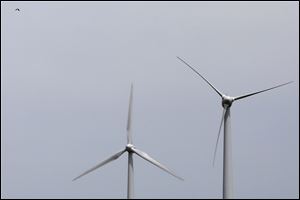
Turbines are part of a clean energy future for northern Ohio
7/28/2018
A bird passes near a pair of wind turbines near Camp Perry near Port Clinton.
Northern Ohio stands to be an innovation leader with the six-turbine Icebreaker Wind demonstration project proposed eight to 10 miles off the Cleveland shore. Icebreaker will be the first freshwater offshore wind project in North America, and can be the stepping stone to a clean energy industry in Northern Ohio that would create thousands of good paying jobs, pump hundreds of millions of dollars into the economy and help clean our air and water.
For the past decade, numerous scientific studies have been conducted of the fish and wildlife populations that inhabit the waters and use the air space surrounding the project site. It is not fair to say, as was recently expressed in a column in The Blade, that Icebreaker Wind poses a significant threat to birds and bats.
After extensive review, the U.S. Fish and Wildlife Service stated the project poses “limited direct risk’’ to migratory birds and bats and is “not likely to adversely affect any [federally listed] threatened or endangered species.” It is also not fair to say that the comments filed by the Black Swamp Bird Observatory and others were ignored by state and federal agencies. And, it is not fair to label the science behind the review by many agencies — including the Ohio Power Siting Board staff, the Ohio Department of Natural Resources, the Ohio EPA, the US Department of Energy, and the US Army Corps of Engineers — as poor and their research as flimsy.
The preliminary conclusion of those agencies — that the project poses minimal and primarily short term risk to the environment — rests on their own independent review of rigorous scientific studies conducted not only by reputable firms hired by LEEDCo, but also studies by state and federal agencies and the extensive public comments filed by the Black Swamp Bird Observatory and dozens of others with the agencies.
The undisputed studies conclude that:
● There are very few waterfowl and waterbirds more than seven miles from shore (Icebreaker is eight miles out)
● There are lower numbers of nocturnal migrants (songbirds) flying over the Icebreaker project site than at areas along shore; most songbirds migrate above the rotor swept zone of the turbines.
● While bats were found over water, they are more commonly found over land.
● The small size of the project significantly reduces the risk it poses.
Icebreaker Wind is taking steps to reduce potential impacts to birds and bats. The blades will not spin at low wind speeds, when bats are most active. This one step has been shown to reduce bat fatalities around wind turbines by 30 percent. The best available collision detection technology will be used and turbines will be shut down during periods of low cloud cover during peak migration if the project begins to operate before this technology is installed. Icebreaker will also use bird-friendly lighting on the turbines.
Those who oppose clean wind power need to ask themselves: If not wind, what? Should we rely on coal, natural gas, and oil for energy, which have helped create a climate crisis (the leading threat to bird populations worldwide) and are polluting our air and water? Should we rely on nuclear power, for which we have been unable to find an answer to the waste storage question?
As energy sources go, wind in general, and Icebreaker Wind specifically, are relatively benign energy sources that will help us address the biggest environmental threats we and our children face today and in the future.
We are pleased that the OPSB staff, which has exhaustively reviewed this project for the last 18 months, agrees that Icebreaker Wind “serves the public interest” and poses “minimal adverse environmental impact.”
This progressive, well-engineered and comprehensively reviewed project enjoys the support of environmental groups such as the Sierra Club, the Ohio Environmental Council, Green Energy Ohio, and the Environmental Defense Fund.
For many reasons — economic impact, jobs, and clean energy — Icebreaker also has the support of community leaders, labor unions, and many elected officials — including Congresswoman Marcy Kaptur — across the state.
Beth A. Nagusky is the director of sustainable development for the Lake Erie Energy Development Corporation.